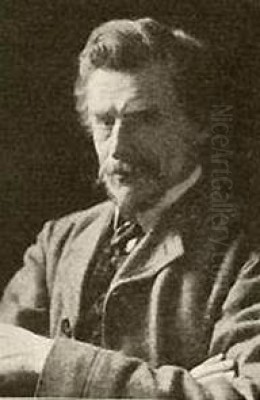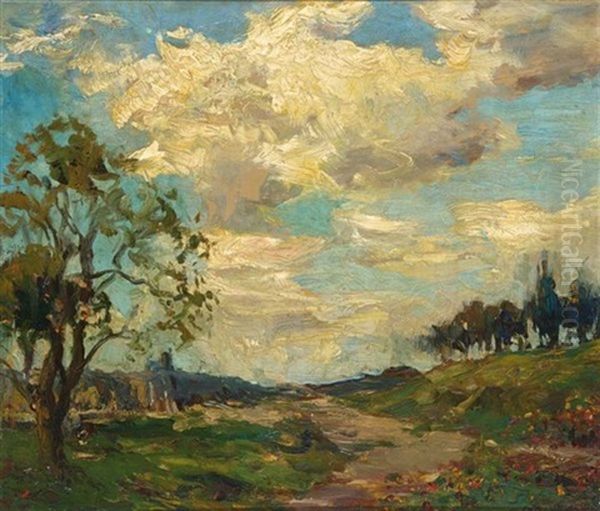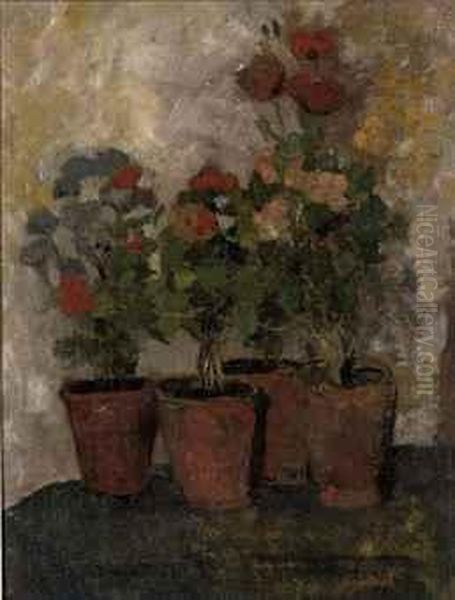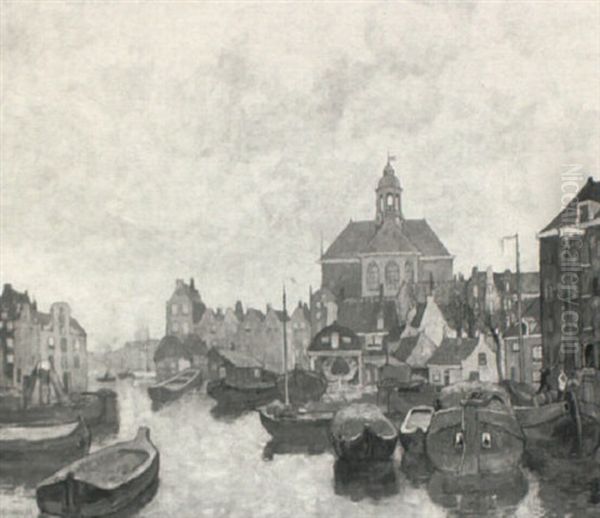
Charles Dankmeijer (1861-1923) was a Dutch artist whose life and career spanned a pivotal period in European art. While perhaps not as internationally renowned as some of his contemporaries, Dankmeijer was an active participant in the Dutch art scene, particularly associated with the Impressionist movement. His work, primarily focusing on landscapes, portraits, and still lifes, reflects the artistic currents of his time and offers insight into the development of modern art in the Netherlands.
Early Life and Nationality
Born in 1861, Charles Dankmeijer's origins trace back to Westphalia, Germany, a region that is now part of Lower Saxony. Despite his German birthplace, Dankmeijer is firmly recognized and identified as a Dutch artist. This Dutch identity is central to understanding his artistic context, placing him within the rich tradition of Dutch painting and its evolution at the turn of the 20th century. The specific town of his birth in Westphalia is not widely documented, but his subsequent career and associations were deeply rooted in the Netherlands. He passed away in 1923, leaving behind a body of work that contributes to the narrative of Dutch Impressionism.
Artistic Pursuits and Impressionist Leanings
Charles Dankmeijer's artistic output was diverse, encompassing landscapes, portraits, and still life paintings. He is noted for his engagement with Impressionism, a movement that had revolutionized art in France and subsequently found its own distinct expressions across Europe. Dankmeijer was connected with prominent Impressionist painters in the Netherlands, such as Jan Toorop and Hendrikus van Ingen. These connections suggest his involvement in the early experiments and adoption of Impressionistic techniques within the Dutch art community.
The core tenets of Impressionism – the emphasis on capturing the fleeting effects of light and atmosphere, the use of broken brushstrokes, and a brighter palette – would have informed Dankmeijer's approach. His landscape paintings, in particular, likely sought to convey the sensory experience of the Dutch countryside or urban scenes, focusing on the interplay of light and color rather than precise, academic representation. Similarly, his portraits and still lifes would have benefited from the Impressionist liberation of color and form, allowing for more expressive and less formal depictions.
The "Pictura Veluwen" Exhibition of 1913

A significant event in Dankmeijer's career, and for the Dutch Impressionist movement, was the "Pictura Veluwen" exhibition held in 1913. This exhibition was a substantial showcase, featuring over one hundred paintings, drawings, and etchings by more than fifty artists. Charles Dankmeijer was among the participating artists, contributing multiple works that demonstrated his exploration and experimentation within the Impressionist style. Such exhibitions were crucial for artists to present their work to the public, engage with critics, and foster a sense of community among like-minded painters.
The "Pictura Veluwen" exhibition included other artists associated with Impressionism, such as Anton Smeeren and Xeno Munneringhoff. The presence of Dankmeijer alongside these figures underscores his active role in this artistic circle. The range of subjects displayed – landscapes, portraits, and still lifes – indicates the breadth of Impressionist application in the Netherlands, moving beyond its initial focus on open-air landscape painting. For Dankmeijer, this exhibition would have been an important platform to assert his artistic vision and contribute to the dialogue surrounding modern art in his country.
Contemporaries and Artistic Milieu
The Dutch art scene at the turn of the 20th century was vibrant and multifaceted. While Impressionism was a significant force, it coexisted with lingering traditions of the Hague School and emerging Post-Impressionist and modernist tendencies. Dankmeijer operated within this dynamic environment. His association with Jan Toorop is noteworthy, as Toorop himself was a versatile artist who explored various styles, including Symbolism, alongside his Impressionist work. This connection might suggest a broader artistic curiosity on Dankmeijer's part.
Hendrikus van Ingen, another contemporary linked with Dankmeijer, was also part of the Impressionist wave. The Netherlands at this time saw influential figures like George Hendrik Breitner and Isaac Israëls, who became leading proponents of Amsterdam Impressionism, known for their depictions of urban life. While Dankmeijer's specific interactions with Breitner or Israëls are not detailed in the provided information, their prominence would have undoubtedly shaped the artistic landscape in which Dankmeijer worked.

Other important Dutch artists of this broader period include Willem Witsen, known for his atmospheric etchings and paintings of Amsterdam, and Floris Verster, whose still lifes often showed an intense observation that sometimes bordered on a precursor to Symbolism or a more personal form of Realism. The legacy of the Hague School, with artists like Anton Mauve (with whom Dankmeijer is mentioned as having a connection, possibly a collaborative or influential one), Jacob Maris, and Matthijs Maris, provided a foundation of naturalism and atmospheric landscape painting upon which Dutch Impressionism built and reacted. Dankmeijer's work can be seen as part of this continuum, absorbing influences while forging his own path. He was also a close contact of Willem de Zwart, a versatile artist associated with both the Hague School and Amsterdam Impressionism, known for his vigorous brushwork and diverse subject matter.
Teaching and Influence: The Case of Ben Viegers
Beyond his own artistic production, Charles Dankmeijer played a role in nurturing talent. He is documented as being a friend and teacher to Ben Viegers (Bernardus Petrus Viegers, 1886-1947). Viegers went on to become a notable Dutch Impressionist painter in his own right, known for his colorful landscapes, cityscapes, and flower still lifes. Viegers participated in an exhibition in Antwerp in 1907 and later held an exhibition in Batavia (present-day Jakarta) in 1910, indicating his growing recognition.
Dankmeijer's mentorship of Viegers highlights an important aspect of an artist's legacy: the transmission of knowledge and artistic passion to the next generation. This teaching role suggests that Dankmeijer was respected within his artistic community not only for his own work but also for his ability to guide and inspire younger artists. The influence of a teacher can be profound, shaping a student's technique, aesthetic sensibilities, and approach to their career. The success of Ben Viegers as an Impressionist painter speaks to the quality of guidance he may have received from Dankmeijer.
Representative Works and Artistic Characteristics
While a comprehensive catalogue of Charles Dankmeijer's most famous works is not readily available in the provided summary, some details emerge. His oeuvre primarily consisted of landscapes, portraits, and still lifes, aligning with the common subjects of Impressionist painters. One specific work mentioned is titled "havegezielt," a painting on cotton measuring 37 x 50 cm, with an estimated auction value of €200-400 and a work number of 1371. The title "havegezielt" is somewhat unusual and might be a specific Dutch term or a unique title whose precise meaning requires further linguistic or art historical investigation.
Generally, Dankmeijer's Impressionist works would likely exhibit characteristics such as:
Emphasis on Light and Color: Capturing the transient effects of light, using a palette that could range from bright and vibrant to more subdued and atmospheric, depending on the subject and mood.
Visible Brushstrokes: Applying paint in a way that the individual strokes remain visible, contributing to the texture of the painting and conveying a sense of immediacy.

Outdoor Scenes (En Plein Air): For his landscapes, he likely practiced painting outdoors to directly observe and capture the nuances of natural light, a hallmark of Impressionism.
Everyday Subjects: Focusing on scenes from daily life, the natural environment, or portraits of individuals, rather than historical or mythological narratives.
The works shown at the 1913 "Pictura Veluwen" exhibition would have been representative of his style during that period, showcasing his engagement with these Impressionistic principles.
A Note on "New Objectivity"
An interesting dimension to the perception of Dankmeijer's art comes from the Dutch art critic Kasper Niehaus. Niehaus reportedly categorized some of Dankmeijer's work under the umbrella of "New Objectivity" (Nieuwe Zakelijkheid). This art movement, which gained prominence in Germany in the 1920s (Neue Sachlichkeit) and had parallels in other countries, was generally a reaction against the abstraction of Expressionism and the perceived subjectivity of Impressionism. New Objectivity favored a return to realism, often with a sharp, detailed, and sometimes detached or satirical representation of reality.
If Niehaus associated Dankmeijer with New Objectivity, it suggests that Dankmeijer's style might have evolved or contained elements that resonated with this later movement. Perhaps some of his later works exhibited a greater degree of clarity, structure, or a more sober realism compared to the more purely optical concerns of Impressionism. This could indicate a versatility in Dankmeijer's artistic approach or a transition in his style over time, reflecting the shifting artistic currents of the early 20th century. It's also possible that certain aspects of his Impressionism, perhaps a strong underlying drawing or a particular focus on form, were interpreted by Niehaus through the lens of the emerging New Objectivity. This connection warrants further exploration to fully understand its implications for Dankmeijer's oeuvre. The influence of artists like Paul Cézanne, who bridged Impressionism and Cubism with his emphasis on underlying structure, was also being felt across Europe, potentially leading to more structured approaches even within broadly Impressionistic frameworks.
Artistic Impact and Legacy
Charles Dankmeijer's artistic impact can be assessed through his contributions to Dutch Impressionism, his participation in significant exhibitions like "Pictura Veluwen," and his role as an educator. While he may not have achieved the same level of fame as some of his Dutch contemporaries like Breitner, Israëls, or international figures like Claude Monet or Pierre-Auguste Renoir, his work was part of the rich tapestry of European art at a time of significant change.
His dedication to Impressionist principles, evident in his landscapes, portraits, and still lifes, helped to propagate this style within the Netherlands. The act of painting itself, exploring light, color, and personal observation, was a contribution to the artistic discourse of his era. His connection with other artists, including Jan Toorop, Hendrikus van Ingen, Anton Mauve, and Willem de Zwart, places him firmly within the network of Dutch painters who were navigating the transition from 19th-century academic traditions to more modern forms of expression.
The fact that he taught and mentored artists like Ben Viegers further solidifies his legacy. Influencing another generation of painters is a vital way in which an artist's impact extends beyond their own lifetime. Viegers' own success as an Impressionist reflects positively on Dankmeijer's abilities as a teacher and his commitment to the principles he espoused.
The mention by Kasper Niehaus regarding New Objectivity also adds a layer to his legacy, suggesting that his work might have possessed qualities that anticipated or aligned with later artistic developments, or at least was complex enough to be interpreted through different stylistic lenses. This indicates an artist whose work was not static but potentially evolved or contained multifaceted elements.
Conclusion
Charles Dankmeijer stands as a noteworthy Dutch artist of the late 19th and early 20th centuries. Born in Germany but Dutch by artistic identity, he dedicated his career to painting, primarily in an Impressionist style. His landscapes, portraits, and still lifes contributed to the vibrancy of the Dutch art scene. Through his participation in exhibitions such as "Pictura Veluwen" in 1913, his connections with fellow artists like Jan Toorop and Anton Mauve, and his mentorship of painters like Ben Viegers, Dankmeijer played an active role in the artistic life of his time.
While further research might unearth more specific details about his individual masterpieces or the nuances of his stylistic development, the available information paints a picture of a dedicated artist working within the Impressionist tradition, yet possibly touching upon aspects of emerging movements like New Objectivity. His life (1861-1923) coincided with a period of immense artistic innovation, and Charles Dankmeijer was a part of that story, contributing his unique vision to the enduring legacy of Dutch art. His work serves as a reminder of the many talented individuals who, while not always achieving household-name status, collectively shape the course of art history.